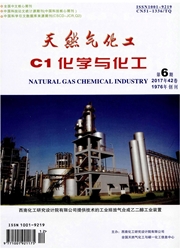

 中文摘要:
中文摘要:
分析温度变化对氢在活性炭上等量吸附热的影响,从而为构建活性炭低温吸附储氢系统提供技术支持.选用比表面积为2074 m2.g-1的椰壳型SAC-02活性炭,在低温区间77.15~113.15 K,压力范围0~8 MPa;较高温区间253.15~293.15 K,压力范围0~11 MPa,用Setaram PCT Pro E&E测试氢在活性炭上的吸附等温线,并由Ozawa对吸附相作过热液体的假设确定绝对吸附等温线.根据绝对吸附平衡数据,在不同温度区间进行等量吸附线标绘,确定等量吸附热,并由亨利定律常数确定极限吸附热.结果表明:氢在SAC-02活性炭上低温区间、较高温区间和整个温度区间内的等量吸附热平均值分别为4.80,6.44,5.62 kJ.mol-1,极限吸附热平均值分别为6.89,8.38,7.64 kJ.mol-1,必须选用活性炭吸附储氢温度区域吸附数据的等量吸附线标绘,才能确定用于分析吸附过程热效应的等量吸附热.
 英文摘要:
英文摘要:
For obtaining the technical data to develop the hydrogen storage system by adsorption on carbon based materials,the influence of temperature variation on the isosteric heat of hydrogen adsorption on activated carbon was evaluated based on the hydrogen adsorption data covering a larger temperature range.A coconut shell-type SAC-02 activated carbon,which has a specific surface area about 2074 m2·g-1,was selected as an adsorbent.Setaram PCT Pro EE was used to measure the adsorption isotherms over a lower and higher temperature region respectively from 77.15~113.15K and 253.15~ 293.15 for pressure up to 11 MPa.The superheated liquid assumption presented by Ozawa was used to calculate the density of hydrogen molecules confined within the adsorbed phase.Adsorption isosteres of hydrogen were plotted by the determined absolute adsorption amount to set the isosteric heat of hydrogen adsorption,and the limit isosteric heat of hydrogen adsorption was calculated by temperature dependence of Henry law constants.It was given from analysis results that the mean value of the isosteric heat of hydrogen adsorption on the SAC-02 activated carbon in the lower temperature region,in the higher temperature region as well as in the whole temperature region was 4.80,6.44 and 5.62 kJ·mol-1 respectively;the average value of limit isosteric heat of hydrogen adsorption was 6.89,8.38 and 7.64 kJ·mol-1 respectively.Conclusions were drawn that adsorption equilibrium data in the same temperature range as that of the hydrogen adsorption storage system should be used to determine the isosteric heat of adsorption for analyzing the thermal effect during the adsorption process.
 同期刊论文项目
同期刊论文项目
 同项目期刊论文
同项目期刊论文
 期刊信息
期刊信息
